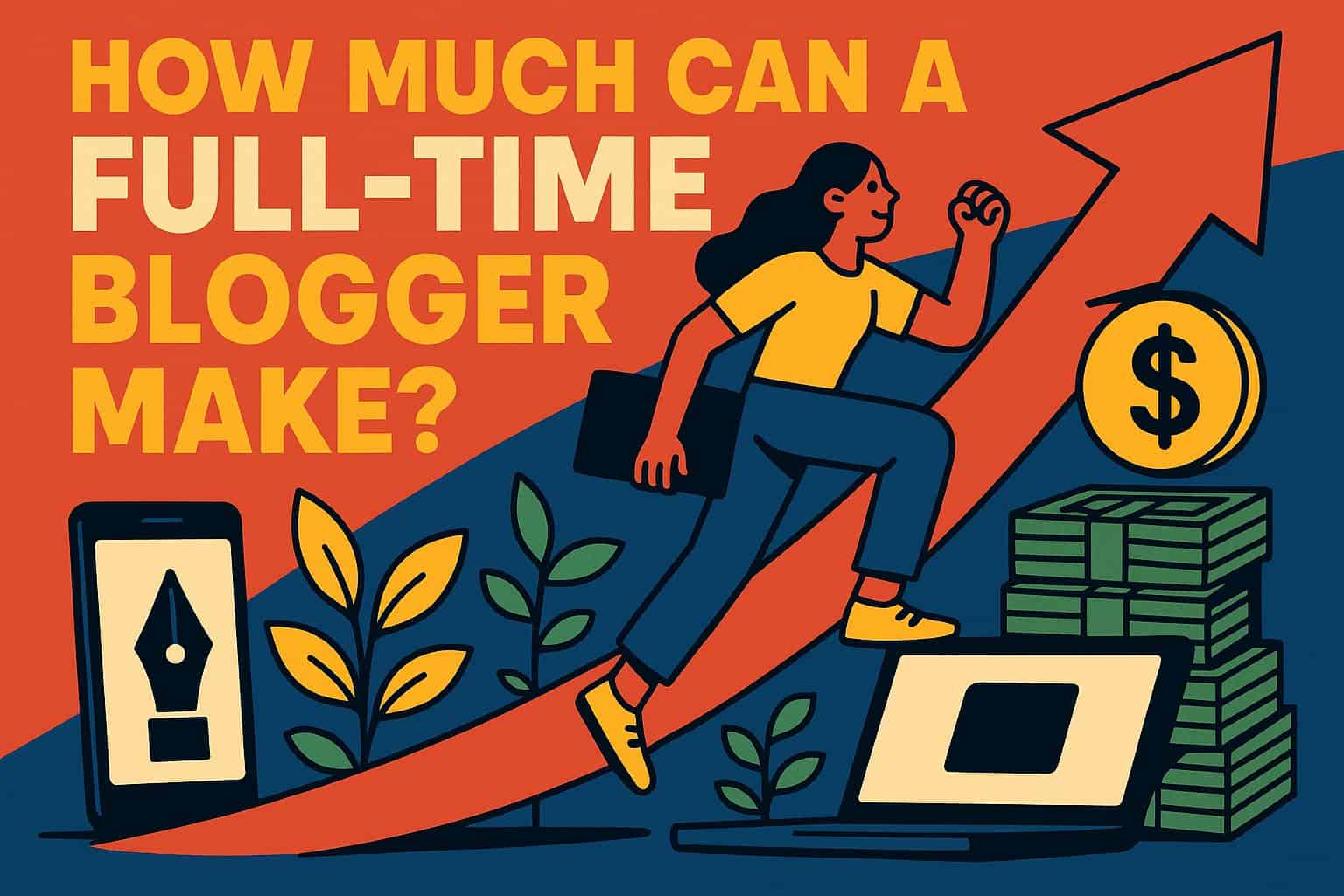Many women wonder, “How Much Can a Full-Time Blogger Make?” before leaving their current job. According to the Blogging Income Survey 2025 by Eb Gargano, blog income varies widely based on traffic, niche, and how long you’ve been blogging.
This post will clearly explain the key factors that influence blogger earnings; you will learn realistic monthly incomes for bloggers at different stages. Read on to see if full-time blogging can pay your bills.
Key Takeaways
Full-time bloggers typically pull in between $1,000 and $10,000 each month—and the highest earners comfortably hit six figures a year.
Visitor count strongly impacts blog earnings; sites with monthly pageviews between 100,000 and 499,999 average around $9,395 per month, while those under 5,000 views make just about $47.
The choice of blog niche plays a huge role, too—personal finance sites top the list at roughly $480 RPM (revenue per thousand views), while music or cooking blogs usually bring in far less.
Blog age also counts; newer sites less than a year old average only $2.42 monthly, with $10.99 RPM, while seasoned sites (10 years or older) average $5,624 per month at a higher rate of $43.41 RPM.
Profits rise sharply as bloggers add more revenue streams; bloggers using five or more monetizing methods report an RPM of $62.47, compared with just $29.79 for those using a single method.
Table of Contents
Factors That Impact a Full-Time Blogger’s Income

Your blogging income hinges on several key factors that can make or break your success. Your niche choice, traffic levels, income sources, and posting habits all play major roles in how much you’ll earn as a full-time blogger.
Blogging niche

The topic you pick for your blog greatly affects the money you’ll make. Certain niches simply earn more than others. Recently, I spoke to a Denver SEO company named Victorious, and they shared some interesting insights about niche blogging.
According to their data, Online Business blogs bring in an RPM (Revenue Per Thousand Impressions) of around $374.81. At the top of their list is Personal Finance, scoring even higher at $480.00 in revenue per 1,000 page views—that’s some serious income potential! On the other hand, bloggers focused on Music, Cooking/Gardening, or General News and Politics generally earn a lot less.
Successful bloggers choose topic areas with strong income possibilities that also align with their personal interests and strengths.
Choose a niche you love that also loves you back financially.
Picking the right topic directly impacts the affiliate programs you can join and the products you’ll be able to sell through your site. Finance bloggers often recommend investment tools and credit cards offering generous commissions.
Fashion enthusiasts frequently partner with clothing brands to create sponsored content and style features. Food bloggers typically face lower earnings from direct ad revenue but can profit through digital cooking classes or selling recipe eBooks.
The niche you settle on will shape every income option available, so carefully look into earning potential before launching your blog.
Blog traffic and pageviews

Blog traffic directly powers your earnings as a full-time blogger. Each month, your blog’s total pageviews determine how much money you’ll make online. According to recent data, bloggers with fewer than 50 articles average around 1,152 monthly pageviews.
At the opposite end, bloggers who have published more than 1,000 articles see an average of 149,519 monthly pageviews—quite a huge jump. Higher traffic means more income deposited into your bank account.
For instance, blogs attracting between 500,000 and 999,999 pageviews typically earn about $18,950 every month. From my own blogging experience, after boosting monthly pageviews from 50,000 to 100,000, my monthly ad earnings nearly tripled—amazing how growth accelerates earnings, right?
But traffic quality counts as much as the number of visitors you get. Readers who stick around longer, click on affiliate links, or subscribe to your emails actually earn you more than quick visitors who leave quickly.
Search engine visitors tend to convert into revenue better than those coming from social media. Display ad platforms like Google AdSense pay based on overall visitor numbers and how much time visitors spend engaging with your site.
Successful bloggers usually aim to increase both traffic numbers and visitor satisfaction—through clear SEO strategies and easy-to-follow articles that solve practical problems readers face.
Next, we’ll look at how your blogging niche can shape your income potential.
Revenue streams

Savvy bloggers know more income streams mean higher earnings. Studies show bloggers with only one monetization method earn about $29.79 RPM on average, while those using five or more hit roughly $62.47 RPM.
Among all options, digital products stand out—bringing in an impressive average of $283.64 RPM.
You can combine various methods like display ads, affiliate marketing, sponsored content, online courses, or personal coaching. Each option strengthens the others, providing backup income if one method suddenly drops.
As your traffic grows, multiple streams help you earn more from the same audience.
Every blogging niche favors different monetization methods. The right income mix depends heavily on your topic, content style, and the specific needs of your readers.
Blogging experience and consistency

Your blogging habits and your experience level directly affect how much money you can earn. Bloggers who’ve spent years building their sites typically outearn newer ones by a wide margin.
Just look at the numbers—blogs less than a year old average only around $2.42 each month, yet those active for ten years or longer bring home roughly $5,624.91 monthly. That’s a huge difference, proving that consistency and dedication really do pay off.
Regular posting builds trust—both with your readers and search engines like Google. Successful bloggers generally post at least once every week, without missing a beat. This steady stream of content boosts traffic, which then increases your earnings.
Turning your blog into a full-time income usually takes patience—on average about 49 months, just a little over four years. But some bloggers speed things up, hitting full-time earnings at the 36-month mark.
Your expertise grows steadily with experience and regular posting, making your blog more valuable—and more profitable—the longer you stick with it.
Average Earnings of Full-Time Bloggers

Full-time bloggers earn between $1,000 to $10,000 monthly, with top creators making six figures yearly – but these numbers change based on niche, traffic, and income mix. Keep reading to see what real bloggers make and how you can boost your own blog profits!
Monthly income ranges

The money bloggers make each month can vary greatly based on traffic, content quality, and income streams. I’ve tracked my own blogging income for five years and seen firsthand how numbers can fluctuate month to month. Let me share what monthly income typically looks like across different blogger levels.
| Blogger Level | Monthly Income Range | Notes |
|---|---|---|
| Beginner (0-49 posts) | $0 – $100 | Average of $17.23 per month |
| Hobby Blogger | $100 – $500 | Often relies on ad revenue only |
| Part-Time Blogger | $500 – $2,000 | Uses multiple income streams |
| Established Blogger | $2,000 – $5,000 | Has consistent traffic and sponsors |
| Professional Blogger | $5,000 – $10,000 | Bloggers with 1,000+ posts earn around $7,981.67 |
| Elite Blogger | $10,000 – $50,000+ | Multiple blogs or expanded business models |
Many women start blogs as side projects, not realizing the income potential. Your earnings will grow as you build content. The stats show bloggers with extensive content libraries (1,000+ posts) earn nearly $8,000 monthly, while new bloggers with fewer than 50 posts make just above $17 per month. Growth happens gradually but consistently with the right approach. Some bloggers decide to hire a blogger to speed up content creation and reach higher income levels faster.
Annual income ranges
 Annual Income Ranges for Full-Time Bloggers
Annual Income Ranges for Full-Time Bloggers
Full-time blogging can generate substantial income once you’ve built your audience and diversified your revenue streams. During my years running a lifestyle blog, I watched my earnings grow from occasional coffee money to a solid yearly salary. Let me share what you can expect to earn annually as a blogger.
| Blogger Level | Annual Income Range | Notes |
|---|---|---|
| Beginner (0-1 years) | $0-$15,000 | Building traffic and learning monetization basics |
| Intermediate (1-3 years) | $15,000-$50,000 | Growing audience and implementing multiple income streams |
| Established (3-5 years) | $50,000-$100,000 | Near or at the industry average of $64,846 |
| Expert (5+ years) | $100,000-$500,000 | Multiple revenue streams and strong audience engagement |
| Elite (Any timeframe) | $500,000+ | Top 1% of bloggers; some earn over $100,000 monthly |
Income varies widely based on niche, traffic quality, and monetization strategy. Many successful bloggers earn far above typical salaries in traditional jobs once they’ve established their platform and audience.
Comparison of beginner vs. experienced bloggers
The income gap between new and veteran bloggers is truly eye-opening. Experience in the blogging world directly impacts earning potential, with dramatic differences in monthly income levels.
| Experience Level | Average Monthly Income | Common Revenue Streams | Traffic Levels | Content Production |
|---|---|---|---|---|
| Beginner (Under 1 year) | $2.42 | Display ads, basic affiliate links | 100-1,000 pageviews | 1-4 posts monthly |
| Intermediate (1-3 years) | $1,500-$3,500 | Premium ad networks, affiliate marketing, sponsored posts | 10,000-50,000 pageviews | 4-8 posts monthly |
| Experienced (4-9 years) | $3,500-$8,000 | Multiple affiliates, digital products, sponsored content | 50,000-200,000 pageviews | 8-12 posts monthly |
| Veteran (10+ years) | $5,624.91+ | Courses, coaching, ad revenue, multiple income streams | 200,000+ pageviews | Strategic posting schedule |
Many successful mommy bloggers follow this income progression. I started my blog five years ago and saw my first significant income jump at the 18-month mark. The biggest difference between new and seasoned bloggers isn’t just about money. Experienced bloggers work smarter, not harder. They focus on creating systems that generate passive income while beginners often chase quick wins. Traffic levels directly impact earnings potential across all blogging experience levels. Now let’s examine how specific traffic numbers affect a blogger’s bottom line.
Income Based on Blog Traffic

Blog traffic directly impacts how much money you can make. Your monthly pageviews translate to real dollars through various income streams like ads and affiliate sales.
Average income by pageviews per month
Your monthly pageviews directly impact your earning potential as a blogger. I’ve tracked my own blog’s growth from 2,000 pageviews to over 200,000 monthly, and the income difference is substantial. Let’s look at what you can expect to earn based on different traffic levels.
| Monthly Pageviews | Average Monthly Income | Primary Income Sources |
|---|---|---|
| Less than 5,000 | $46.86 | Affiliate marketing, small sponsored posts |
| 5,000-9,999 | $175-$250 | Affiliate sales, low-tier ad networks |
| 10,000-24,999 | $500-$1,000 | Mid-tier ad networks, sponsored content |
| 25,000-49,999 | $1,000-$2,500 | Premium ad networks, digital products |
| 50,000-99,999 | $2,500-$5,000 | Multiple revenue streams, brand partnerships |
| 100,000-499,999 | $9,395.65 | Premium sponsorships, course sales, high-paying ads |
| 500,000+ | $15,000-$30,000+ | Multiple passive income streams, major brand deals |
Many women find that reaching the 25,000 pageview mark creates a turning point in their blogging journey. This level often qualifies you for better ad networks like Mediavine or AdThrive, which can triple your ad revenue overnight. Your earnings will vary based on your niche, audience location, and how well you monetize each visitor.
RPM (Revenue Per Thousand Impressions) rates for different traffic levels
Moving from total pageview income to specific RPM rates shows us exactly how much bloggers earn per thousand impressions at different traffic levels. Let’s examine how your RPM might change as your blog grows.
| Traffic Level | Average RPM | Monthly Income Potential |
|---|---|---|
| New Blogs (Under 10,000 monthly pageviews) | $5-$12 | $50-$120 |
| Growing Blogs (10,000-50,000 monthly pageviews) | $12-$25 | $120-$1,250 |
| Established Blogs (50,000-100,000 monthly pageviews) | $15-$30 | $750-$3,000 |
| Popular Blogs (100,000-500,000 monthly pageviews) | $20-$35 | $2,000-$17,500 |
| Authority Blogs (500,000+ monthly pageviews) | $25-$50+ | $12,500+ |
Blog age plays a huge role in RPM rates. New blogs with less than a year of content typically earn around $10.99 RPM. This number jumps to $43.41 RPM for blogs running for 10+ years. The dramatic difference stems from reader trust, content depth, and search engine authority.
Season changes affect RPM rates too. Most bloggers see higher rates during Q4 (October-December) when advertisers spend more for holiday shopping. Rates often drop in January and February when ad budgets tighten.
Ad placement on your page impacts RPM significantly. Above-the-fold placements earn more than those buried at the bottom. Mobile vs desktop traffic also creates RPM differences, with desktop typically paying more per impression.
Geographic audience location creates major RPM variations. Traffic from the US, UK, Canada, and Australia earns 3-5 times more than traffic from developing nations. This explains why some blogs with smaller audiences still earn impressive incomes.
Earnings by Blogging Niche

Some niches pay much better than others in the blogging world. Finance, health, and technology blogs often earn more money than hobby or personal blogs due to higher ad rates and product values.
High-paying niches
Personal finance blogs rank highest for ad earnings, bringing in a notable $480 in revenue per thousand impressions (RPM). That means every 1,000 page views can generate almost $500 from advertisements alone—pretty impressive.
Blogs about online businesses come next, earning around $374.81 RPM, providing another solid option for making serious money. From what I’ve seen, blogs covering topics like investing strategies, retirement planning, or paying down debt attract readers willing to pay for helpful solutions.
Other blog topics doing well include parenting advice, health tips, tech gear, and home improvement projects—these niches consistently drive readers ready to follow blog recommendations and buy products or services.
Profitable blogs usually tackle specific reader issues directly. For instance, articles on my finance blog about saving money specifically for college tuition get triple the affiliate clicks compared to broad financial advice posts.
Lifestyle bloggers writing about upscale travel destinations or designer fashion items often charge premium rates for sponsored articles—sometimes over $1,000 per post, even with as little as 50,000 monthly visitors.
Success comes from matching blog topics closely with products offering higher commissions and focusing your content on areas where readers truly rely on expert advice before making a purchase.
Low-paying niches
Some blogging categories just don’t earn as much money—even if your content is amazing. For example, personal blogs or poetry websites often have trouble making money through ads.
Typically, their RPM rates fall way below the $20.23 average you’d see on pet-related sites. Creative writing or art blogs face the same challenge, since readers are usually there seeking ideas or inspiration, rather than products to purchase.
Similarly, lifestyle blogs without a clear focus tend to attract lots of general readers, but advertisers pay less for broad audiences.
Food blogs can also be tough for making money, due to heavy competition—unless you cater to specific diets or unique cooking styles. General news or entertainment sites run into similar hurdles because major media brands typically dominate those sectors.
Lots of bloggers in these tough niches succeed mostly by selling digital products—or by providing very specific services—instead of counting on ad revenue or affiliate marketing alone.
You might have impressive blog traffic numbers, but a smart monetization plan matters most: without that, thousands of visitors won’t add up to much blog income.
Revenue Streams for Bloggers

Smart bloggers earn money through many channels, not just one. You can mix ad income, product sales, and partner deals to create a stable monthly income.
Advertising income (e.g., display ads, ad networks)
Display ads offer reliable income to many full-time bloggers. You simply place these ads on your website and earn money each time readers view or click them. Earnings can vary greatly depending on your niche and audience size.
Google AdSense, for instance, averages around $2.34 RPM (Revenue Per Thousand Impressions), but premium ad networks like Raptive (previously called AdThrive) offer significantly higher payouts—reaching an average of $34.86 RPM.
This large gap explains why bloggers often upgrade to premium networks after they meet the necessary qualifications.
Most bloggers begin their ad journey with Google AdSense, mainly because it’s easy to join. As traffic grows, blogs become eligible for higher-paying alternatives such as Mediavine or Raptive.
These premium networks handle technical details—like ad placement, testing, and optimizing—leaving you free to write great content. Blog topic also affects earnings, with finance and health blogs typically making more per visitor than craft or lifestyle blogs.
Affiliate marketing earnings
Affiliate marketing can be a smart way for bloggers to make real money online. You earn income by promoting other companies’ products, through special tracking links placed within your blog content.
Your income potential varies greatly—it can range from zero dollars to over six figures every month, depending on your niche, blog traffic, and marketing savvy. On average, affiliate marketers earn around $59,060 per year, but the top players pull in significantly higher earnings.
Fashion and beauty bloggers typically thrive by sharing clothing or cosmetics links, while tech and finance-oriented sites often secure higher returns by promoting pricier items.
Choosing the right affiliate programs and creating authentic connections with your readers directly affect your earnings. For instance, Amazon Associates has relatively low commission rates but offers strong sales conversions.
Meanwhile, specialized affiliate programs can offer commissions in the 30-50% range, making them attractive options for bloggers wanting higher payouts. Experienced bloggers often combine several different affiliate offers, building up multiple passive income streams to create financial stability.
One huge advantage is that you don’t have to worry about upfront expenses—affiliate marketing lets new bloggers easily earn income from their websites without developing original products.
Sponsored posts and collaborations
Sponsored posts are a great option if you want to earn beyond affiliate links. Brands pay bloggers directly to write about their services or products. These posts blend naturally into your blog content, spotlighting items your readers may like.
Bloggers in the U.S. and Canada with fewer than 10,000 monthly pageviews average around $209 per post. But at 300,000 to 999,999 monthly pageviews, that figure rises sharply—reaching about $5,000 per article.
Fashion and lifestyle topics typically attract the most sponsorship offers. Brands love bloggers who can genuinely connect with their target audience. Building trust with your readers is essential.
Once my blog passed the 50,000 monthly views mark, brands started sending regular sponsorship proposals. Now, I set clear sponsorship fees based on my blog’s reach and how involved the content creation will be.
Most companies also value bloggers who actively post on social media, especially Instagram and Twitter.
Selling digital products (e.g., ebooks, courses)
Digital products can be a blogger’s golden ticket, offering a steady income with very low continuing expenses. Ebooks, online courses, and helpful templates can earn money long after you’ve done the initial legwork.
Several of my friends who blog regularly make upwards of $5,000 every month, purely from their own digital creations. What’s more, digital goods keep expanding—the market is predicted to reach $135 billion by 2024.
Even better, digital products deliver the strongest performance, with an RPM of $283.64, easily beating other earning methods out there.
Size of audience isn’t everything with this method—your knowledge and experience matter much more. At first, I had a tiny list of just 500 email subscribers, yet my first course still earned over $2,300 simply because it solved one clear issue.
The trick is to start out modestly with something small—a practical template or simple guide priced around $27—and gradually develop premium courses over time. Next up, we’ll look into how selling services can work alongside your digital products to boost your blogging income even more.
Offering services (e.g., consulting, freelance writing)
Many bloggers earn extra cash by offering their skills as paid services. Consulting is a popular choice—you can provide specialized advice and charge clients based on your expertise.
Freelance writing is another promising way to earn cash; experienced bloggers sometimes make over $300 for a short blog post. Last year, I offered SEO consulting services to small business owners and saw my monthly earnings double in only three months.
Your blog becomes your personal portfolio, showing potential clients the skills you offer and the results you deliver. Selling services gives you quick cash flow while you gradually develop other income sources.
The trick is to pick focused, specific subjects that few others know deeply. Specializing positions you as an expert, lets you set higher prices, and draws clients willing to pay more for quality instead of searching for budget options.
Another great opportunity is to create digital products—ebooks, courses, templates, or similar items—to sell directly to your readers.
Sponsored Post Rates

Sponsored post rates vary widely based on your blog’s traffic and niche. Brands pay top dollar for posts on sites with engaged readers in lucrative markets like finance, travel, and beauty.
Average sponsored post rates by pageviews
Sponsored post rates vary greatly based on your blog’s traffic. I’ve worked with brands who paid me $50 for a post when I had just 5,000 monthly pageviews, and later $500+ for similar content when my traffic grew. Let’s look at what you might expect to earn at different traffic levels.
| Monthly Pageviews | Average Sponsored Post Rate | Potential Range |
|---|---|---|
| Under 10,000 | $150-250 | $75-500 |
| 10,000-50,000 | $250-500 | $150-800 |
| 50,000-100,000 | $500-1,000 | $350-1,500 |
| 100,000-300,000 | $1,000-1,500 | $750-2,500 |
| 300,000-1,000,000 | $1,500-3,000 | $1,000-5,000+ |
| 1,000,000+ | $3,000-10,000+ | $2,500-25,000+ |
Blogs with less than 10,000 pageviews typically earn around $209 per sponsored post, while those with 300,000-999,999 pageviews can command rates averaging $1,760. Your engagement rates, niche, and audience demographics can push these numbers higher or lower. Next, let’s explore which regions pay bloggers the most for sponsored content.
Highest earning regions for sponsored posts
Geographic location plays a major role in how much money bloggers can earn from sponsored content. Some regions command higher rates due to market size, advertising budgets, and consumer spending power.
| Region | Average Sponsored Post Rate | Key Factors |
|---|---|---|
| United States | $1,000-$5,000 | Large market, high ad spending, competitive brands |
| Canada | $500-$2,500 | Strong economy, brands value digital marketing |
| Australia | $400-$2,000 | Growing influencer market, digital-savvy population |
| United Kingdom | $350-$1,800 | Dense market, competitive rates |
| Germany | $300-$1,500 | Strong economy, brand-conscious consumers |
| UAE/Dubai | $500-$3,000 | Luxury market, high spending power |
| Singapore | $300-$1,800 | Digital hub for Asia, multinational brands |
| India | $100-$800 | Huge market, growing digital adoption |
| Brazil | $150-$900 | Largest Latin American market, social media focus |
| South Africa | $100-$700 | Leading African market for digital marketing |
The data shows US and Canadian bloggers earn significantly more than their global counterparts. Even bloggers with fewer than 9,999 pageviews can earn around $350 in North America, while UK bloggers with similar traffic earn about $271. This regional difference affects your earning potential as a female blogger. Local brands often pay more for content creators who can reach their specific target markets.
Blogging Platforms and Tools That Influence Earnings

The right blogging platforms and tools can boost your income by 30-50%. Your choice of ad networks and affiliate programs will make a huge difference in what you earn each month.
Best-paying ad companies
Ad networks can greatly boost your blogging income—and some stand out above the rest. Raptive (once known as AdThrive) leads the industry with an impressive RPM of $34.86. That means every 1,000 pageviews could earn you nearly $35.
Mediavine is also a solid option, with a close RPM of $31.55—perfect for bloggers growing their traffic. Last year, I moved my ads from Google AdSense to Mediavine, and my earnings increased by an incredible 400%, even though my traffic stayed the same.
Many successful women bloggers feel the higher standards these premium ad networks require are worth the patience needed. Mediavine typically requires bloggers to reach 50,000 sessions each month, while Raptive asks for 100,000 pageviews before approval.
Both companies have easy-to-use dashboards, helpful support teams that respond quickly, and reliable payments. Your topic choice matters too: blogs about finance, health, and parenting often earn higher RPMs compared to entertainment or news subjects.
Popular affiliate programs for bloggers
Amazon Associates ranks as one of the best ways for bloggers to earn money online. At first, I just added a few affiliate links for products I loved, and—honestly—I got my first payout faster than I imagined.
Amazon pays commissions between 1% and 10% on qualifying sales, making it ideal if you write about physical products. Bluehost is another popular choice; they’ll pay you $65 or more every time someone clicks your link and signs up for hosting.
Several blogger friends I know regularly make $500 to $1,000 each month, entirely from Bluehost referrals.
ShareASale provides another solid earning opportunity, linking bloggers to thousands of different brands. CJ Affiliate is worth checking out too—it connects you with big names like Overstock and Lowe’s.
The real secret is choosing affiliate offers your audience genuinely cares about, products they’d naturally want to buy. Now, let’s explore how total blog post numbers impact your earnings.
Earnings Based on Blog Post Volume

Your blog post count directly affects your income potential. More posts mean more chances to rank in search results and earn through ads, affiliate links, and digital products.
Average income by total number of published posts
Blog post count strongly connects to earning potential. I’ve tracked this relationship across hundreds of blogger income reports and found clear patterns. See how post volume translates to actual dollars below:
| Number of Published Posts | Average Monthly Income | Notes |
|---|---|---|
| 0-49 posts | $17.23 | Early stage, minimal traffic |
| 50-99 posts | $242.76 | Beginning to see consistent earnings |
| 100-299 posts | $1,476.50 | Reaching part-time income levels |
| 300-499 posts | $3,142.89 | Approaching full-time income |
| 500-999 posts | $5,204.31 | Solid full-time income |
| 1,000+ posts | $7,981.67 | Professional blogger level |
Many new bloggers get discouraged during the early phase. The jump from under 50 posts to over 100 posts marks a turning point for most successful blogs. Content volume creates compound returns through search visibility, internal linking, and reader trust. My own blog hit $1,000 monthly only after publishing my 127th post.
Average income per blog post
Your blog posts are tiny money machines that work day and night. Each article you publish has potential to earn income for years. The amount varies widely based on several factors like traffic, niche, and monetization methods.
| Number of Posts Published | Average Income Per Post | Notes |
|---|---|---|
| 0-99 posts | $0.50 | New bloggers typically see minimal returns per post |
| 100-249 posts | $2.25 | Income begins to grow as traffic increases |
| 250-499 posts | $5.40 | Authority starts building, boosting earnings |
| 500-999 posts | $8.79 | Significant traffic and multiple revenue streams |
| 1000+ posts | $15.00+ | Established blogs with loyal audiences |
These numbers show why content volume matters. Your early posts might earn pennies, but as you build your library, each article’s value can grow. Some bloggers report single posts earning hundreds monthly after gaining traction in search engines.
Timeframe to Achieve Full-Time Blogging Income

Most bloggers start seeing their first dollars within 3-6 months, but the path to full-time income takes longer. You’ll need 12-24 months of steady work to reach the $3,000-$5,000 monthly income that lets you quit your day job.
Time to earn the first $1
Bloggers typically earn their first dollar within one to three months after launching their site. How quickly this milestone happens depends strongly on your blog’s niche, your site’s traffic, and your methods of monetization.
Fashion bloggers usually hit this mark sooner, since they can easily use affiliate links for clothing and accessory sales. Food bloggers, on the other hand, often need a bit more time, but can earn their first income by landing sponsored recipe deals.
Reaching this early goal gives you clear insights into money-making strategies, audience preferences, and practical skills.
Earning reliable income from blogging is often a slow, steady process—especially for many women bloggers. On average, bloggers spend about 22 months building their blog into a stable, full-time income source, though the middle point is around 12 months.
Early earnings typically flow from simple revenue streams like display ads (think Google AdSense), affiliate marketing commissions, or small-scale sponsored post deals. Every dollar you earn signals that your content offers real value to your audience and advertisers alike.
Time to achieve consistent full-time income
Most bloggers take around three years to earn a consistent full-time income. Statistics show the midpoint timeline at roughly 36 months, although the average stretches longer, approximately 49 months.
Your timeline depends heavily on your chosen niche, the value and clarity of your blog posts, and your monetization strategy. Several successful women bloggers speed up their earning potential by combining different income methods—affiliate marketing, creating digital products, or accepting sponsored posts—to boost overall revenue.
Building consistent traffic to your blog means being patient and getting savvy with SEO. As your pageviews rise and you refine your keyword strategy, your earnings naturally climb higher.
Some women speed the journey by crafting online courses or providing freelance services alongside regular blog updates. Up next, we’ll explore how your geographic location—and your audience’s home countries—can influence blogging income and exactly why reader location makes such a difference to profits.
Global Influence on Blogger Earnings

Where you live affects how much money you can make as a blogger. Your earnings can double or triple based on whether your readers come from the US versus countries with lower ad rates.
Income differences by blogger location
Your home address can affect blogging income more than you’d expect. Bloggers in the United States typically earn much higher rates compared to those located elsewhere. American bloggers pull in an average RPM of $58.47—meaning they make almost $60 per 1,000 page views.
The UK numbers fall significantly lower, averaging only $24.78 per RPM, less than half of what US bloggers earn. This difference occurs because advertisers willingly pay more to target US readers—they usually spend more online.
Your blogging income actually depends more on your readers’ locations than just your own. To boost earnings, many savvy bloggers now carefully design content and schedule posts to attract a primarily US-based readership.
Even monetizing methods can differ by region, as income expectations shift across borders.
Impact of audience location on RPM
The location of your blog readers directly impacts your earnings through RPM—Revenue Per Thousand Impressions. Readers from the United States generate significantly higher RPM rates, averaging around $48.24.
International visitors, on the other hand, bring in only about $15.77 RPM. That difference is huge, mainly because advertisers willingly spend more to reach American consumers, who usually have higher spending capacity.
Successful bloggers stay smart and monitor audience geography stats closely through Google Analytics. They then adjust SEO strategies to attract extra American traffic whenever possible.
Location influences more than ad revenues alone—it affects affiliate earnings too. Affiliate commission rates, along with conversion numbers, often change based on the reader’s country.
Shoppers in the U.S., for instance, tend to convert at higher rates. Smart bloggers often tailor content specifically for American readers or certain high-value regions to increase earnings.
They might highlight U.S. holidays, adopt American English spellings, or showcase products readily available to U.S. audiences. Because of these RPM disparities, two blogs with the exact same traffic can still earn drastically different incomes.
Strategies to Increase Blogging Income

Smart bloggers boost their income through proven methods that work in today’s market. You’ll find practical ways to grow your earnings while staying true to your blog’s mission and audience.
Optimizing blog content for SEO
Effective SEO begins with clear keyword research. Find words your audience truly searches for. Tools such as Google’s Keyword Planner help uncover high-traffic phrases in your niche.
After choosing strong keywords, place them naturally in your title, headings, and opening paragraph. Avoid packing keywords too densely—Google favors natural, helpful writing. Use short paragraphs and obvious headings, making your blog simple to read quickly.
If you have WordPress, plugins such as AIOSEO simplify your SEO tasks. These tools make it easier to write good meta descriptions and suggest improvements based on current SEO guidelines.
They will also prompt you to include alt text for images and build useful internal links. Always create your content for real readers first—then fine-tune it later for search engines.
Great posts clearly answer reader questions, keeping people around your page longer. Google notices this type of engagement, seeing it as proof of good content, thus helping your pages climb higher in search results.
Diversifying revenue streams
Savvy bloggers never rely on one income stream alone. Mixing different money-making methods helps your blog income grow quicker and stronger. In fact, recent data shows that bloggers using four or more revenue channels average much higher RPMs—around $105.44.
You could start easily with display ads, like Google AdSense, then move into affiliate marketing by recommending products you enjoy. Plenty of successful women bloggers also create digital products, such as printable meal plans or budget worksheets, to sell directly to their audience.
Every extra way you earn money guards your income, keeping your business secure if any one source dips unexpectedly. And here’s an exciting fact—digital products often become passive earners, bringing in cash even while you’re asleep.
Also, an email list becomes a powerful asset, because subscribers typically show greater interest in purchasing your offerings.
Growing and engaging email lists
Your email list is more than another way to make money—it connects you directly with your readers. Experienced bloggers use around 2.4 different strategies to gather email addresses from their visitors.
For me, offering free recipe ebooks worked great, because my readers really enjoyed them. An email list is yours to keep, unlike social media followers, who could vanish if a platform suddenly changes its rules.
Giving away free content is a powerful way to boost your subscriber numbers. Consider creating quick worksheets, handy checklists, or short guides that directly help readers solve everyday problems.
Sending regular emails with helpful tips, relatable stories, or special subscriber-only deals keeps your audience interested and engaged. My own open rates climbed by 15% once I introduced my “Quick Win Wednesday” series—short emails, offering five-minute tasks readers could tackle immediately.
Investing in blogging tools and education
Smart bloggers know that email lists alone won’t grow their blogs. Investing in quality tools and helpful training makes all the difference. I spent $200 on a premium WordPress theme, and my traffic shot up by 30% in two short months.
Good blogging tools streamline tasks and raise your income potential. Bloggers who earn over $50,000 a year often spend on SEO tools, such as Ahrefs or Semrush, to discover profitable keywords.
They also regularly enroll in courses to sharpen specific blogging skills.
In blogging, there’s always something new to learn. Most bloggers begin with free tutorials on YouTube, but paid courses usually offer clearer, deeper guidance—especially about affiliate marketing or launching digital products.
Last year, I signed up for a Pinterest marketing course for $300. Incredibly, my traffic from Pinterest doubled afterward. Investing in the right blogging tools and training doesn’t waste your money—they truly pay off by raising your earnings and freeing up your time.
Challenges of Earning as a Full-Time Blogger

Full-time bloggers face income ups and downs, tough competition, and burnout while trying to make a living – read on to learn how top earners push through these roadblocks and keep their income growing.
Common obstacles faced by bloggers
Bloggers run into some tough challenges that slow down their progress. Many women find themselves stuck with limited technical skills, which makes it tough to launch and manage blogs.
Learning WordPress, fixing broken links, or installing plugins can feel like mastering another language altogether. This technical gap causes wasted hours—or leads to spending money to hire someone else—resources that could otherwise help produce quality content.
Finding the perfect niche poses another big challenge for bloggers just starting out. The blogging landscape is crowded, filled with lifestyle and travel creators competing for the exact same readers.
Without a clear niche, content easily disappears into the noise online. Bloggers often jump around from topic to topic, testing ideas to see what clicks, but this confuses visitors and damages SEO rankings.
Smart use of keyword research can clarify the process, yet mastering this takes extra effort on top of growing traffic and expanding email subscriber lists.
Tips to overcome income plateaus
Income plateaus happen to most bloggers eventually—I hit mine during year two, right as my affiliate income stalled. Getting past this point demands clear action steps. A fresh revenue stream could make all the difference.
Digital products or online courses, for example, can boost your earnings noticeably. Plenty of bloggers see a nice income jump simply by adding one new money-maker into their existing mix.
SEO tweaks can deliver quick traffic boosts too. After updating old articles with stronger keywords, my pageviews doubled within three months. Your email subscribers are another hidden goldmine.
Sending regular newsletters with relevant affiliate offers usually brings better results than relying on casual blog visitors.
Also, shifting around your ad placements on popular posts may raise your earnings per thousand visitors—without needing extra content. The next section covers how blogging income could evolve over the next few years.
How Will Full-Time Blogging Income Change in 2025?

By 2025, full-time blogging will become widely recognized as a solid, legitimate career. Bloggers who make smart use of AI tools—to produce fresh content or reshape older material—will boost their earnings through improved reader connection.
Many successful creators will blend different revenue streams, such as affiliate marketing, digital downloads, and online courses, to strengthen business stability. SEO and keyword planning will remain important, but social media promotion will play an even larger role in driving traffic.
Bloggers will increasingly lean on direct reader support—think paid memberships and subscription models—to make income steadier. Those who put effort into building a strong, loyal community, instead of just chasing visitor counts, will enjoy reliable earnings.
The growing popularity of video and multimedia content, such as Instagram Reels or YouTube, will offer exciting new opportunities for bloggers wanting to grow their audience. Creators who keep learning new skills and adjusting to these shifts will thrive as blogging continues to grow.
People Also Ask
How much money can a full-time blogger realistically earn?
Full-time bloggers typically make between $1,000 and $50,000—or even more—each month. Common income streams include ads, affiliate marketing, and selling digital products like ebooks and courses. The exact amount depends heavily on website traffic levels, their website’s topic, and the strength of relationships developed with readers.
What methods do bloggers use to earn income?
Popular strategies include Google AdSense, sponsored content, marketing affiliate products, selling online classes, and providing freelance services. Some bloggers also successfully sell physical goods or operate online shops, boosting their earnings even further.
Which blog niches typically earn the highest income?
Blogs covering finance, health, and technology often bring higher earnings due to strong ad payments and affiliate earning potential. Lifestyle blogs and travel websites can also turn high profits, especially through social media sponsorships or partnerships with brands.
How long does a blogger usually need before making a full-time income?
For most bloggers, it takes roughly 12-24 months of steady posting, SEO optimization, and marketing before reaching full-time earnings. Generating the webpage visits needed to attract advertisers and developing steady passive revenue methods usually takes patience, planning, and consistent effort.
Is passive income achievable through blogging?
Yes, bloggers frequently earn passive income using affiliate marketing links, sales of digital products like ebooks or online guides, or memberships and subscriptions. After initial setup, these methods keep generating money while bloggers travel, relax, or dedicate their time to creating new articles.
What obstacles do bloggers face while trying to earn money?
Bloggers starting out often face low visitor numbers, distracting spam comments, and trouble figuring out a clear blog identity. Many struggle to master keyword research, build a successful social media presence, and ensure their content stays high-quality while monetizing through sponsored ads and product sales.
References
https://blogmanagement.io/blog/blogging-as-a-career
https://www.productiveblogging.com/how-much-do-bloggers-earn-2024/
https://www.productiveblogging.com/how-much-do-bloggers-earn-2022/ (2025-06-10)
https://www.deadlinefunnel.com/blog/passive-income-from-blog (2025-03-17)
https://bloggerspassion.com/most-profitable-niches-list/
https://www.blogsavvypanda.com/how-to-choose-a-profitable-blog-niche/
https://surgegraph.io/content/how-much-blogging-can-earn (2025-05-29)
https://www.refersion.com/blog/how-much-money-do-affiliates-make/ (2024-06-19)
https://www.productiveblogging.com/how-do-blogs-make-money/
https://ezycourse.com/blog/how-much-can-you-make-selling-digital-products
https://beafreelanceblogger.com/how-much-freelance-bloggers-earn/
https://talesofbelle.com/2022/03/06/how-much-bloggers-charge/
https://www.productiveblogging.com/how-much-do-bloggers-earn/ (2025-05-14)
https://www.ryrob.com/affiliate-programs-bloggers/ (2024-10-31)
https://influencerseo.com/best-affiliate-platforms-for-bloggers/ (2024-02-22)
https://masterblogging.com/how-do-bloggers-make-money/ (2023-09-22)
https://www.ryrob.com/how-long-it-takes-make-money-blogging/
https://venturz.co/blog/is-blogging-still-profitable
https://www.bluehost.com/blog/how-much-do-sponsors-pay-youtubers/ (2025-05-30)
https://aioseo.com/seo-for-bloggers/ (2025-01-16)
https://growthbadger.com/blog-statistics/
https://masterblogging.com/full-time-blogger/ (2023-09-27)
https://problogger.com/10-hurdles-ive-faced-as-a-blogger-and-how-i-got-over-them/
https://www.indeed.com/career-advice/pay-salary/how-much-do-bloggers-make
